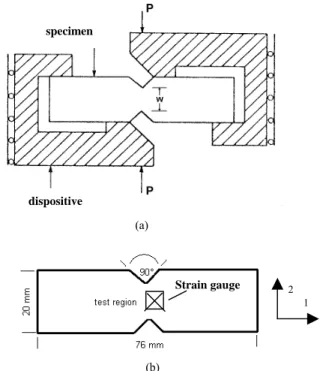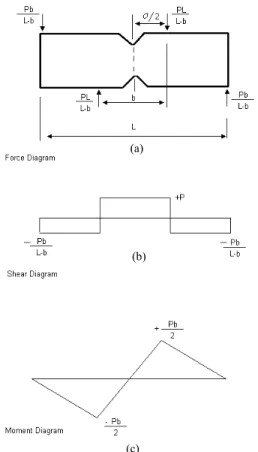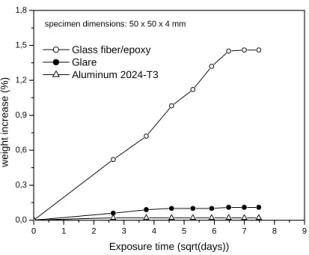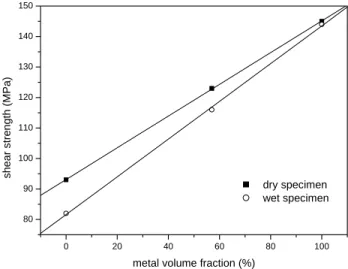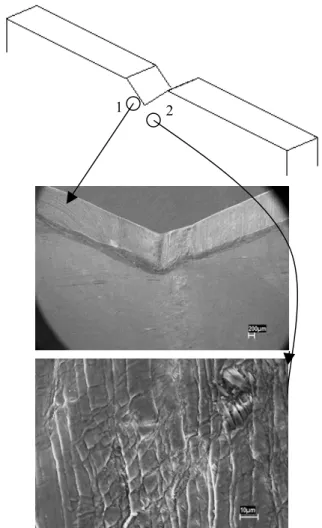Edson C. Botelho
ebotelho@directnet.com.br UNESP Dept of Materials and Technology Guaratinguetá, SP, Brazil
Mirabel C. Rezende
mirarezende@uol.com.br
Luis Claudio Pardini
lpardini@directnet.com.br CTA-IAE Materials Division São José dos Campos, SP, Brazil,
Hygrotermal Effects Evaluation Using
the Iosipescu Shear Test for Glare
Laminates
Fiber-metal laminates (FML) composed of alternating layers of unidirectional fiber-reinforced plastic (FRP) laminae and aluminum-alloy sheets offer some superior mechanical properties, compared with either conventional laminates consisting of only FRP laminae or high-strength monolithic aluminum alloys. The environmental factors can limit the applications of composites by deteriorating the mechanical properties during service. Usually, polymeric matrix absorbs moisture when exposed to humid environments and metals are prone to surface corrosion. On the other hand, FML laminates presents more resistance of moisture when compared with their constituents. Evaluation of shear properties is particularly important in the design of mechanically fastened parts and components, which are subject to parallel and opposing loads. In this work, the shear behavior was studied for Glare laminates and its constituents in dry and wet conditions. Keywords: metal/fiber composites, hygrothermal effects, shear strength properties, Iosipescu shear test; Glare laminate
Introduction
1The development of composites containing more than two
elements (hybrid composites) has been motivated from industry because of the improved performance as well as reduced weight and cost that hybrid composites could provide. Consequently, the complete and accurate knowledge of mechanical properties of hybrid composites becomes important in approximating the design requirements or in developing new hybrid materials (Wang and Yang, 2000; Cantwell et al, 1999; Abrate, 1997 and Zenkert, 1991).
Fiber metal laminates (FMLs) are structural hybrid composite materials that consist of thin aluminum alloy sheets bonded alternately with fiber-reinforced epoxy layers. These hybrid materials offer superior mechanical properties over conventional polymer composite laminates or high-strength monolithic aluminum alloys (Dymácek, 2001; Asundi and Choi, 1997; Vogelesang and Vlot, 2000; Lin and Kao, 1995; Naboulsi and Mall, 1997 and Vlot and Gunnink, 2001).
Glare is a second generation of FML materials that consists of glass fiber/epoxy laminae and aluminum alloy sheets (Soprano et al, 1996; Castrodeza et al, 2002). In contrast with ARALL, FML based on aramid fibers, little tensile residual stress remains in the aluminum–alloy layers of Glare after curing. This is due to the positive axial thermal expansion of glass in the fiber direction. This feature enables us to use GLARE in as-cured state and in various configurations including a cross-ply lay-up (Soprano et al, 1996; Castrodeza et al, 2002).
In general, FMLs combine high specific strength and excellent fatigue properties typical of the polymeric matrix composites and the formability of aluminum alloys, gathering together the better of these two worlds. They have good impact resistance, corrosion, lightning strikes, and fire resistance. They also exhibit better specific strength in the direction of the reinforcing fibers and fatigue crack growth is many times slower than the current monolithic alloys. This combination of properties makes these laminates extremely attractive for utilization for primary (GLARE) or secondary aircraft structures (ARALL) and also in those which require impact resistance, corrosion, and flame (Asnafi et al, 2000; Wittenberg, Van Baten and Boer, 2001; Takamatsu et al, 1999; Kawai et all, 2001; Kawai et al, 1998; Young, Landry and
Paper accepted March, 2008. Technical Editor: Anselmo Eduardo Diniz.
Cavoulacos, 1994; Botelho, Pardini, and Rezende, 2006a; Botelho, Pardini, and Rezende, 2006b).
Polymeric composite materials in practical use may be subjected to mechanical stresses and environmental attacks. The main environmental attacks are related to temperature, moisture, radiation, and contact with several kinds of chemicals. Mechanical properties, such as interlaminar shear strength (ILSS), ultimate tensile strength, compressive strength, fracture strain and stiffness are the primary static mechanical properties, which normally decrease with the increase of moisture content (Botelho, Pardini, and Rezende, 2005a; Botelho et al, 2004; Rastogi, Soni, and Nagar, 1998; Cândido and Almeida, 1993; Sala, 2000; Zhang and Mason, 1999).
Environmental agents that usually cause damage to composites are electromagnetic effects, fire, and high temperatures; lightning and electrical discharges, ozone (chemical degradation); ultra-violet radiation; out-gassing at high-vacuum; erosion by rain, sand, etc.; low-energy impacts that induce barely visible impact damage; moisture uptake and contact with organic liquids such as fuels, lubricants and de-icing fluids. During normal service aircraft are exposed to all these agents in a time-variable manner (Botelho, Pardini, and Rezende, 2005a; Botelho et al, 2004; Rastogi, Soni and Nagar, 1998; Cândido and Almeida, 1993; Sala, 2000; Zhang and Mason, 1999).
Many materials have adequate static strength for structural purposes, but have little durability when exposed to hot moisture environments. The action of moisture in metals leads to corrosion. Pure aluminum is a very reactive metal, which quickly builds up an oxide layer on its surface. This oxide layer in turn protects the aluminum from degradation due to environmental exposure. In order to improve the corrosion resistance, a protective layer can be applied onto the surface of the material. This can be done by anodization, leading to a clad layer of pure aluminum (Botelho, Pardini, and Rezende, 2005; Botelho et al, 2004). On the other hand, in polymer composite materials, the influence of moisture is most notably present in the matrix that absorbs moisture when exposed to humid environments, as a result of a diffusion process (Costa, Almeida and Rezende, 2001; Botelho et al, 2005b).
and He, 2002; Unal, Barard and Anderson, 1999; John and Brown, 1998; Tarnopol’skii, Arnautov and Kulakov, 1999; Botelho et al, 2003).
The adhesion between fibers and matrix and/or between aluminum and epoxy is responsable to govern the interlaminar shear strength in composite materials. The ideal shear test must be simple enough to perform, require small and easily fabricated specimens, enable measuring of very reproducible values for both shear modulus and shear strength at simple data procedure (Chiang and He, 2002; Unal, Barard, and Anderson, 1999; John and Brown, 1998; Tarnopol’skii, Arnautov and Kulakov, 1999; Botelho et al, 2003).
Different devices for the study of the shearing properties of composites are proposed in the literature (Iosipescu, 1967). One of the most used shear test, which allows a nearly pure-shear stress state at the shear plane, was proposed by N. Iosipescu (Iosipescu, 1967). The test essentially consists of a double v-notched beam specimen, to which two counter reacting forces are applied, such that a state of pure shear is generated along the specimen midsection (Iosipescu, 1967).
The purpose of the present work is to evaluate the effect of the hygrothermal conditioning in the shear behavior of Glare laminate and these individual constituents (aluminum 2024-T3 and glass fiber/epoxy composite). In this work, specimens of Glare and glass fiber/epoxy composites were evaluated by Iosipescu and short beam shear tests.
Experimental Procedure
Materials
Glass fiber/epoxy (GF/E) prepreg having F 155 specification was used for metal/fiber laminate preparation, supplied by Hexcel Co. The fiber reinforcement for the F 155 prepreg is a plain weave fabric with [0/90] orientation. Aluminum alloys 2024-T3 sheets were supplied by Empresa Brasileira de Aeronáutica (EMBRAER).
Glare was prepared by stacking alternating laminae of the glass fiber/epoxy prepreg and the aluminum sheet. The lay-up scheme of the hybrid composites was 3/2 (three aluminum and two glass fiber/epoxy layers), as depicted in Fig. 1. In order to promote the adhesion and protect the aluminum sheet against environmental effects, a chromic acid anodizes (CAA) method was used.
Figure 1. Configuration of continuous glass fiber/metal/epoxy hybrid composite (3/2 lay up).
After the lay-up process, the laminates were fit in a vacuum bag and placed in the autoclave system. The curing cycle was done at a heating rate to 2.5°C/min up to 120°C and this final temperature was held during 1 hour. The pressure and the vacuum used were 0.69MPa and 0.083MPa, respectively. The curing cycle was followed as described in previous works (Botelho et al, 2004).
Environmental Conditioning
Glass/epoxy and Glare specimens were exposed to a combination of temperature and humidity in an environmental conditioning chamber in order to assess the influence of the environmental conditioning on the shear behavior. Environmental conditioning was selected to saturate the specimens before the mechanical tests were based on Procedure B of ASTM Standard D 5229 M-92. During conditioning, the temperature was set at 80°C and the relative humidity (RH) in the chamber was set to 90%.
Shear Strength Tests
The shear strength behavior of the FML materials were evaluated by two type tests: Interlaminar shear (ILSS) and Iosipescu shear. The interlaminar shear test (short beam shear test) was done according to ASTM D2344. The tests were performed in an Instron mechanical testing machine using a test speed of 1.3 mm/min.
The Iosipescu test method measures the shear properties of composite materials. The sample coupon is shown in Fig. 2. The square area covered by the gages is referred to as the test region in this study. The radius of the notch tips is 1.3 mm. The thickness of specimen was 4.1 mm. In this work, de coordinates x and y and 1 and 2 were coincident.
(a)
(b)
Figure 2. Iosipescu test Scheme: a) Iosipescu dispositive; b) specimen configuration.
The specimen is fit into the fixture and the notch is located along the line-of-action of loading by means of an alignment tool that references the fixture (Fig. 3). The notches influence the shear strain along the loading direction, leading to a more uniform distribution of stresses than would be without the notches. By applying two force couples that generate two counter-acting moments, a pure and uniform shear stress state is generated at section a-b (Fig. 3 -notch roots). The resulting shear and moment diagrams are shown respectively in sections b and c.
aluminum 2024 – T3 glass/epoxylaminae
x
y
z
specimen
dispositive
Strain gauge 2
(c)
Figure 3. Idealized force, shear and moment diagrams for Iosipescu test.
In order to obtain the in plane shear modulus, G12, its necessary assuring that both, stress and strain are uniformly distributed in the test region of the specimen used. In this case, the apparent in-plane shear strain, γ12 at the cross-section along two notch tips can be obtained by (Botelho, Pardini, and Rezende, 2005a; Botelho et al, 2004):
In this work, the Iosipescu tests were done according to ASTM D 5379 and performed in an Instron mechanical testing machine using a test speed of 0.5 mm/min. Shear strain was measured by bonding strain gages at ± 45°, placed at the mid-section between the two notch tips (Fig. 2). The uniformity of shear stress and corresponding strain in the test region need to be examined to assess the accuracy of the shear modulus determination. Due to difficulties in fix strain gauges in wet specimens, it was not possible to obtain the shear modulus for specimens after to be submitted to hygrothermal conditioning.
Microstructural Analysis
Scanning Electron Microscopy (SEM) and Optical Microscopy (OM) were employed in order to characterize the shear failure modes in the glass fiber/epoxy and Glare shear coupons. A Leo 435VPI Microscope was used for SEM analysis. Optical microscopy was done using Olympus BH equipment.
Theoretical G12 Values
Composite micromechanics calculations can be used in order to compare the elastic properties of polymer composites and fiber/metal laminates. Theoretical modelling uses a self consistent model (FGM code) to calculate data for composite elastic constants and so a comparison with experimental data can be done (Pastore and Gowayed, 1994). In the self consistent model, it is considered
that spatially oriented composite rods, which represent fiber bundle orientation, are transversely isotropic.
The matrix and fiber properties used in order to calculate some of the mechanical properties of composite materials (e.g. the elastic modulus E) are shown in Table 1, where Ex and Ey are elastic modulus in x and y directions and υ12 is a poisson’s ratio in the 1-2 plane. So, E1 is the axial (fiber direction) modulus and E2 is the transverse moduli.
γ
12 =ε
+45°-
ε
-45° (1)Table 1. Parameters used in the FGM program and the mixtures rules.
material Volume fraction
content (%)
Ex (GPa) Ey (GPa) G12 (GPa) ν12
Epoxy 40%* 5.00 5.00 1.85 0.30
Glass fiber 60%* 72.0 72.0 28.8 0.14
Aluminum 2024-T3 ~57% 72.4 72.4 28.0 0.33
* Value used only in the polymeric composite
On the other hand, the rule of mixtures (equation 1) has been used in order to calculate the elastic properties of the FML, since the FGM model is not suitable for modeling properties of such hybrid materials.
)
1
(
/c al al c al
al
E
V
E
V
E
=
+
−
(2)where: Eal/c , Eal , and Ec are the elastic moduli of metal/fiber laminate, aluminum and glass fiber/epoxy composites, respectively.
Results and Discussion
Moisture Absorption
Figure 4 shows the weight increase as a function of exposed time for glass fiber/epoxy and Glare composites specimens exposed at 80°C and 90% RH. It is observed that the G/E composite absorbs 1.5% of moisture up to the saturation point (6 weeks). Therefore, the corrosion effect in aluminum was negligible since the mass gain was less than 0.1%. The oxide protective layer, built up by chromic acid anodize treatment, reduces the susceptibility of aluminum to corrosion when exposed to moisture. In Glare laminates, the aluminum sheets are located mainly in the external surfaces. This shields the pathway of moisture desorption by the G/E composite layer, which are only available at the free edges of the laminate. This leads to a significantly lower rate of moisture absorption of the Glare laminates compared to fiber reinforced polymer composites.
The kinetics of the diffusion process depends on the temperature and relative moisture absorption. The higher the relative moisture absorption the greater is the absorption rate. This takes place through a diffusion process, in which water molecules are transported from areas of high concentration to areas of lower moisture concentration. This diffusion process can be described by Fick’s law (Chiang and He, 2002; Unal, Barard and Anderson, 1999; John and Brown, 1998; Tarnopol’skii, Arnautov and Kulakov, 1999; Botelho et al, 2003).
(a)
0 1 2 3 4 5 6 7 8 9 0,0
0,3 0,6 0,9 1,2 1,5 1,8
specimen dimensions: 50 x 50 x 4 mm
we
ig
ht in
crea
s
e
(%)
Exposure time (sqrt(days)) Glass fiber/epoxy
Glare
Aluminum 2024-T3
Figure 4. Weight increase of GF/E composite, aluminum and Glare specimens exposed at 80°C and 90% RH.
Interlaminar Shear Strength
The short beam shear test has been used to measure the apparent interlaminar shear strength (ILSS) of a composite material. This method is not suitable for design information, but data generated from this test method is being used to obtain design allowables, primarily because of the lack of any alternative test methods for measuring interlaminar strength
Table 2 shows the interlaminar shear strength results for GF/E composite and Glare. Using this Table, it was observed that the ILSS values decreases when exposed to hydrothermal condition. Wet conditioning induces strong matrix plasticization. The moisture adsorption is not uniform thoughtout the material.
Table 2. Interlaminar shear strength values for glass fiber/epoxy composites.
τ(MPa) Before hygrothermal Conditioning
After hygrothermal Conditioning Glare 40.9 ± 4.2 37.8 ± 3.7 GF/E 69.3 ± 1.1 67.2 ± 1.9
As depicted in Table 2, the interlaminar shear strength results for glass fiber was ~69MPa and these values are close to results found in the literature (60.0 – 70.0MPa) (Asnafi et al, 2000; Wittenberg, Van Baten and Boer, 2001). Moreover, the interlaminar shear strength results obtained for Glare presented lower values when compared to glass fiber/epoxy composite results (~41.0 MPa), due to the interface of aluminum and epoxy.
According to the Table 2, the interlaminar shear strength values for glass fiber/epoxy composite shows a decrease of 8% after being submitted to hygrothermal conditioning for 60 days. The hygrothermal effects on the mechanical properties of composites are described in detail in the literature (Chiang and He, 2002; Unal, Barard and Anderson, 1999; John and Brown, 1998; Tarnopol’skii, Arnautov and Kulakov, 1999; Botelho et al, 2003) but there is not a general agreement over the magnitude of this effect. The difficulty is to evaluate the influence of both moisture absorption and temperature at the same time on the mechanical properties. On the other hand, the difference of the shear strength values between the wet and the dry Glare specimens was only 3% (Table 2) indicating that the influence of hygrothermal conditioning over Glare was lower than GF/epoxy composites.
Figure 5a presents the morphology of the failure mode aspect in glass fiber epoxy composites specimens after being submitted by ILSS test. It can be observed that the GF/E composite exhibit
multiple delaminations having interlaminar cracks at horizontal and vertical positions. This behavior was observed in both, dry and wet specimens.
(a)
(b)
Figure 5. Failure mode in: a) GF/E composite and b) Glare.
values than fiber/epoxy composites that presents the critical location from the delamination standpoint between the fiber and epoxy.
Theoretical Results
The theoretical calculations show that the GF-E composite has an elastic modulus (E) lower than the aluminum (~72.0 GPa) and, consequently, it is expected that for the Glare the elastic modulus would be lower than metal used as constituent of Glare laminate. A similar behavior can be observed for shear modulus results. Aluminum has a shear modulus of 28.0 GPa and the hybrid composites exhibit a shear modulus of 19.0 GPa. The glass fiber/epoxy composites still present low shear modulus (6 GPa) when compared with the other constituent of Glare (Table 3).
Table 3. Theoretical engineering constants calculated by micromechanics approach.
Specimen
Fiber volume content (%)
Al volume
content (%) Ex(GPa) Ey(GPa) G12(GPa)
GF-E 60.0 0.00 30.6 30.6 6.03
Aluminum
2024-T3* 0.00 100 72.4 72.4 28.0
Glare 25.3 57.9 54.8 54.8 18.8
* literature value (Vlot, Gunnink 2001)
Iosipescu Tests Results
Table 4 presents the results for the shear modulus (G12) and shear strength (τ12), from Glare laminate, glass fiber/epoxy and aluminum 2024-T3 used in this work. It could not be possible to obtain the shear modulus for specimens after being submitted to hygrothermal conditioning due to difficulties in attach strain gauges in wet specimens.
Table 4. Shear strength results obtained in composites before and after to be submitted to environmental conditions.
Parameters Before hygrothermal conditioning Al GF/E Glare
After hygrothermal conditioning Al GF/E Glare
τ12 (MPa) 145 ± 4 98 ± 4 125± 3 140 ± 2 92 ± 3 119 ± 3 G12 (GPa) 26.8 ± 0.8 6.1± 0.7 18.2 ± 0.3 --- --- ---
Glass fiber/epoxy laminate presented the lower Iosipescu shear strength value when compared with the other studied materials (90 MPa). The higher value was found by aluminum 2024-T3 (145MPa). The Glare was produced using 57% v/v of aluminum and 43% of GF/E. By using equation 2, it is possible to calculate a value of 125MPa for the shear strength, following equation (1). The Iosipescu shear strength measured experimentally was 118MPa, which is very close to the theoretical value (~1% of difference). Figure 6 presents the shear yield strength values as a function of the metal volume fractions, according to rule of mixture (Botelho, Pardini, and Rezende, 2005a; Botelho et al, 2004).
E GF E GF al al
Glare
=
τ
⋅
V
+
τ
/⋅
V
/τ
(3)where: τGlare is the theoretical shear stress for Glare; τal and τGF/E are the experimental shear stress values of aluminum 2024-T3 and of glass fiber/epoxy composites, respectively, and Val and VGF/E are the volume of aluminum and glass fiber epoxy composites, respectively. The measurements were performed before and after hygrothermal conditioning. It was observed that in both, GF/E composite and Glare, the shear strength results decrease by nearly 5% for both laminates, after to be submitted to hygrothermal condition. In all specimens analyzed, moisture uptakes always induced resin plasticization and, consequently, reduces the shear strength values of the laminates. The influence of the hygrothermal
effects on the shear strength results was negligible (around 3% of decrease). Although not measured, the shear modulus of moisture conditioned specimens tends to reduce due to resin plasticization effect.
0 20 40 60 80 100
80 90 100 110 120 130 140 150
sh
ear stre
ng
th
(MPa
)
metal volume fraction (%)
dry specimen wet specimen
Figure 6. Shear yield strength versus metal volume fraction for Glare.
The strain gauge response as a function of shear stress, for glass fiber/epoxy composites and Glare laminate are presented in Fig. 7a-b. These plots confirm the non-linear shearing behavior for these materials.
According to the literature, moisture affects the distribution of interlaminar stresses as well as the mechanical behavior of the resin. This was also confirmed from the results obtained in this work.
As can be observed in Fig. 8-10, GF/E composite, aluminum and Glare exhibit different failure modes. In glass fiber/epoxy when loaded, the first observable failure was notch-root splitting which starts near the notch-roots and propagates away from the inner loading blocks along the fibers (damage 1 in Fig. 8). The splitting, in this case, is predominantly a consequence of transverse tension near the notch-roots, showing that the splits create a uniform stress distribution along the notch-root axis. At about the notch-root splits, damage starts to accumulate at the notch-roots or at inner loading blocks (damage 2 in Fig. 8). The damage (crushing) caused by the loading blocks can be significant at higher loads and the shear-strength determination.
0 10 20 30 40 50 60 70 80 -1,8
-1,6 -1,4 -1,2 -1,0 -0,8 -0,6 -0,4 -0,2 0,0 0,2 0,4 0,6 0,8 1,0 1,2 1,4 1,6 1,8
0 10 20 30 40 50 60 70 80 -1,8
-1,6 -1,4 -1,2 -1,0 -0,8 -0,6 -0,4 -0,2 0,0 0,2 0,4 0,6 0,8 1,0 1,2 1,4 1,6 1,8
str
a
in
(%
)
shear stress (MPa) +45° gauge
-45° gauge
(a)
0 20 40 60 80 100 120
-1,4 -1,2 -1,0 -0,8 -0,6 -0,4 -0,2 0,0 0,2 0,4 0,6 0,8 1,0 1,2 1,4
0 20 40 60 80 100 120
-1,4 -1,2 -1,0 -0,8 -0,6 -0,4 -0,2 0,0 0,2 0,4 0,6 0,8 1,0 1,2 1,4
s
tra
in
(%)
shear stress (MPa) +45° gauge
s
tra
in
(%)
shear stress (MPa) -45° gauge
(b)
Figure 7. Strain gauge typical response – Orientation 12: a) glass fiber/epoxy composite; b) Glare laminate.
Figure 10 shows that delamination for Glare occurred between the glass fiber/epoxy prepreg and aluminum 2024-T3. As can be observed in this Fig., this specimen exhibited a damage characterized by multiple shear delaminations at the aluminum-prepreg interface after Iosipescu test. These cracks are formed due mainly to fiber splitting in the lamina and interlaminar shear deformation between the prepreg and the aluminum lamina. According to Fig. 10 can also be observed a typical delamination between glass fiber/epoxy composites and aluminum alloy.
Conclusion
The influence of moisture in shear properties of glass fiber/epoxy composites and Glare laminate have been investigated. It was observed that the G/E absorbed 1.5% of moisture after the saturation point (after 6 weeks). During the hygrothermal conditioning, the protective layer of oxide on aluminum, promoted by chromic acid anodize minimized the corrosion generate by the influence of the moisture. As a result of the presence of aluminum layers on the Glare surfaces, moisture can only penetrate the epoxy from free edges of the laminate. The leads to a significantly lower rate of moisture absorption compared to fiber reinforced composites. It was observed that Glare absorbed less than 0.1% of moisture after the saturation point (after 6 weeks).
Figure 8. Iosipescu failure behavior in [0/90] glass fiber/epoxy composite materials.
For all specimens studied the ILSS values decrease when exposed to hydrothermal condition. Wet conditioning induces strong matrix plasticization. The moisture adsorption is not uniform thoughtout the material.
When evaluated by Iosipescu test, both, GF/E composite and Glare, presented a decrease of the shear strength results by nearly 5%, after being submitted to hygrothermal condition. In all specimens analyzed, moisture uptake always induced resin plasticization and, consequently, reduces of the shear strength values of the laminates. The influence of the hygrothermal effects on the shear strength results was negligible (around 3% of decrease).
Acknowledgements
The authors acknowledge the financial support received from FAPESP under grants 05/54358-7 and 03/04240-4 and CNPq (grant 306053/2006-3). The authors are indebted to Mr. Rogério Silva Almeida from EMBRAER for helping to process the composite materials used in this work.
Figure 9. Iosipescu failure behavior in Aluminum 2024-T3 a) failure mode and b) failure behavior in the notch.
Figure 10. Iosipescu failure behavior in Glare material: a) failure mode and b) failure behavior in the notch.
Figure 10. (Continued).
References
Abrate, S., 1997, “Localized Impact on Sandwich Structures with Laminated Facings”. Applied Mechanical Review, vol. 50, pp. 69-82.
Asnafi N., Langstedt G, Andersson, C-H, Ostergren N, Hakansson T, 2000, “A new lightweight metal-composite-metal panel for applications in the automotive and other industries”, Thin-Walled Structures, vol. 36, pp.289-310.
Asundi A, Choi AYN., 1997, “Fiber metal laminates: An advanced material for future aircraft”, Journal of Materials Processing Technology, vol. 63, pp. 384-394.
Botelho EC, Lauke B, Figiel L, 2003, “Rezende MC. Mechanical Behavior of a Carbon-Fiber-Reinforced Polyamide Composite”, Composites: Science and Technology, vol. 63, pp.1843.
Botelho, EC, Pardini, LC, Rezende, MC. 2006, “A Review on the Development and Properties of Continuous Fiber/Epoxy/Aluminum Hybrid Composites for Aircraft Structures”, Materials Research, vol. 9, pp. 247-256.
Botelho, EC, Pardini, LC, Rezende, MC. 2006b, “Damping Behavior of Continuous Fiber/Metal Composite Materials by the Free Vibration Method”, Composites Part B, vol. 37, pp. 255-264.
Botelho, EC, Pardini, LC, Rezende, MC. 2005a, “Hygrothermal Effects on Damping Behavior of Metal/Glass Fiber/Epoxy Hybrid Composites”, Materials Science and Engineering A, vol. 399, pp. 190-198.
Botelho, EC, Pardini, LC, Rezende, ML, Almeida, RS., 2004, “Evaluation of Adhesion of Continuous Fiber-epoxy Composite/aluminum laminates”, Journal of Applied Adhesion Technology, vol. 18, pp. 1799 – 1813.
Botelho, EC, Pardini, LC, Rezende, ML, Costa, ML., 2005b, “Processing and Hygrothermal Effects on Viscoelastic Behavior of Glass Fiber/Epoxy Composites”, Journal of Material Science, vol. 40, pp. 3615-3623.
Cândido, GM, Almeida SFM., 1993, “Effect of the Free Edge finishing on the Tensile Strength of Carbon/Epoxy Laminates”, Composite Structures, vol. 25, pp. 287-293.
Cantwell, WJ, Scudamore, R., Ratcliffe, J., Davies P., 1999, “Interfacial Fracture in Sandwich Laminates”, Composites Science and Technology, vol. 59, pp. 2079-2085.
Castrodeza, EM, Bastian FL, Yawny A, Ipiña JEP, 2002, “Fracture micromechanisms of fibre-metal laminates: in-situ SEM observation”, Journal of Composite Materials, vol. 35, pp. 1-14.
Chiang MYM, He J., 2002, ”An analytical assessment of Using the Iosipescu Shear Test for Hybrid Composites”, Composites Part B, vol. 33, pp. 461-470.
Costa ML, Almeida SFM, Rezende MC. 2001, “The Influence of Porosity on the Interlaminar Shear Strength of Carbon/Epoxy and Carbon/Bismaleimide Fabric Laminates”, Composites Science and Technology, vol. 61, pp. 2101-2108.
Dymácek P., 2001, “Fiber-Metal Laminates Steel-C/Epoxy. PhD thesis, Institute of Aerospace Engineering”, Faculty of Mechanical Engineering of Brno University of Technology, Czech Republic.
Iosipescu N., 1967, “New accurate procedure for single shear testing of metals”, Journal of Materials, vol. 2(3), pp. 537-566.
John NAS, Brown JR., 1998, “Flexural and Interlaminar Shear Properties of Glass-Reinforced Phenolic Composites”, Composites Part A, vol. 29, pp. 939-946.
Kawai M., Morishita M., Tomura, S., Takumida K., 1998, “Inelastic Behavior and Strength of fiber-metal Hybrid Composite: Glare”, International Journal of Mechanics Science, vol. 40, pp.183-198.
1
2
Kawai M., Hachinohe A, Takumida K., Kawase Y., 2001, “Off-axis fatigue behavior and its damage mechanics modeling for unidirectional fiber-metal hybrid composite: Glare 2”, Composites Part A, vol. 32, pp. 13-23.
Lin CT, Kao P.W., 1995, “Effect of fiber bridging on the fatigue crack propagation in carbon fiber-reinforced aluminum laminates”, Materials Science & Engineering A, vol. 190, pp.65-73.
Naboulsi S, Mall S, 1997, “Thermal effects on adhesively bonded composite repair of cracked aluminum panels”, Theoretical and Applied Fracture Mechanics, vol. 26, pp. 1-12.
Pastore CM, Gowayed YA., 1994, “A self-consistent fabric geometry model: modification and application of a fabric geometry model to predict the elastic properties of Textile Composites”, Journal of Composites Technology & Research, vol. 16(1), pp. 32-36.
Rastogi N, Soni SR, Nagar A, 1998, “Thermal stresses in aluminum-to-composite double-lap bonded joints”, Advances in Engineering Software, vol. 29(3), pp. 273-281.
Sala, G., 2000, “Composite Degradation due to Fluid Absorption”, Composites Part B, vol. 31, pp. 357-373.
Soprano A, Apicella A, D’Antonio L, Schettino F, 1996, “Application of durability analysis to glare aeronautical components”, Int. J. Fatigue, vol. 18(4), pp. 265-272.
Takamatsu T., Matsumura T., Ogura N., Shimokawa T., Kakuta Y., 1999, "Fatigue crack growth properties of a Glare3-5/4 fiber/metal laminate”, vol. 63, pp. 253-272.
Tarnopol’skii YM, Arnautov AK, Kulakov AVL., 1999, “Methods of Determination of Shear Properties of Textile Composites”, Composites PartA, vol. 30, pp. 879-885.
Unal Ö, Barard DJ, Anderson IE. 1999, “A Shear Test Method to Measure Shear Strength of Metallic Materials and Solder Joints Using Small Specimens” Scripta Materialia; vol. 40(3), pp. 271-276.
Vlot A, Gunnink JW. 2001, Fibre Metal Laminates. Kluwer Academic Publishers, Delft, Netherlands.
Vogelesang LB, Vlot A., 2000, “Development of fibre metal laminates for advanced aerospace structures”, Journal of Materials Processing Technology, vol. 103, pp. 1-5.
Wang, B., Yang M., 2000, “Damping of Honeycomb Sandwich Beams”, Journal of Materials Processing Technology, vol. 105, pp. 67-72.
Wittenberg TC, Van Baten TJ, Boer A., 2001, “Design of fiber metal laminate shear panels for ultra-high capacity aircraft”, Aircraft Design, vol. 4, pp. 99-113.
Young JB, Landry JGN, Cavoulacos VN., 1994, “Crack growth and residual strength characteristics of two grades of glass-reinforced aluminum ‘Glare’”, Composite Structures, vol. 27, pp. 457-69.
Zenkert D., 1991, “Strength of Sandwich Beams with Interface Debonding”, Composite Structures, vol. 17, pp. 331-338.
